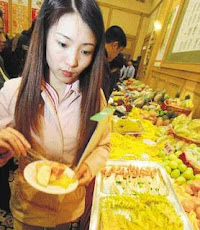PANGLIMA Lane or Yi Lai Hong (Concubine Lane in Cantonese) as it is popularly known, comes across as just another narrow street in Ipoh.
Yet the row of 27 pre-war buildings along the road has never failed to attract tourists, photographers and artists from far and near.
 Old-world charm: The Once notorious Panglima Lane in Ipoh is now drawing a differnt crowd- touristsm shutterbugs and even movie producers.
Old-world charm: The Once notorious Panglima Lane in Ipoh is now drawing a differnt crowd- touristsm shutterbugs and even movie producers.It has, in fact, become a famous landmark, probably more for its notorious label as a place where mistresses are allegedly kept than as a opium haunt in the early 1950s.
Ninety-year-old Wong Koh Kee, the retired boss of Koh Kee Restaurant situated along the lane, however, doubted there were businessmen and tin miners who kept their mistresses there nor were there any brothels.
 Classic design: The horizontal bars doorway is among the olden architecture that attracts visitors from near and afar to visit Panglima Lane in Ipoh.
Classic design: The horizontal bars doorway is among the olden architecture that attracts visitors from near and afar to visit Panglima Lane in Ipoh.“A story that goes round is that opium smokers would always say they are going to their mistresses instead of to the opium den when asked by friends,” he noted.
Wong said despite its reputation, the area was surprisingly peaceful back then with hardly any serious crime.
“One thing for sure is that the place is quiet and peaceful. The folks at the opium dens only wanted to be left alone,” he added.
Today, many people are still interested in the buildings’ architecture along the lane, which mainly serves as a passageway for visitors who parked their cars along Jalan Bijeh Timah to go to the coffeeshops along Jalan Bandar Timah.
 Car-free: Panglima Lane has become a walkway between Jalan Bijeh Timah and Jalan Bandar Timah.
Car-free: Panglima Lane has become a walkway between Jalan Bijeh Timah and Jalan Bandar Timah.“The traditional horizontal bar gates, wooden window panes and bronze door knobs are a rare find for visitors,” said former resident Loh Vooi Leong.
“Tourists could also be seen snapping away pictures of bamboo poles placed across one window ledge to another to dry their clothes,” said the 58-year-old, adding that it was completely new to them.
Loh said the place had also become a favourite spot for location shootings, including for a Hong Kong drama series starring renowned actor Alex Man Chi Leung as well as by local producers filming Chinese New Year music videos and films. Once a hive of activity in the 1950s and 1960s, Panglima Lane is a close-knit community of mostly hawkers and traders where everyone is a familiar face.
Whether it is the birth of a child, the Chinese New Year festivities or even if a resident gets a job, there is always a cause for celebration.
As Loh puts it, “everyone was practically a family member then.”
“In times of duress, we will try to help each other and keep an eye for one another,” he said.
The lane with about 27 prewar shophouses used to house about 100 families. One shophouse would have about four to five families staying under one roof.
“Only six buildings are still occupied, four with families and the other two have become workers’ quarters,” he said, adding the rest were vacant and dilapidated.
Many residents left the place after the Ipoh City Council came down hard on street hawkers in 1998.
Loh, who spent his childhood days in the area, said life was pretty simple then.
“The boys like to play near Sungai Kinta, catching fighting fish in the river and spiders by the embankment. Given some marbles or spinning tops, we would enjoy ourselves for the whole day,” he recalled.
Resident Chou Yuet Lai, 60, said her childhood always revolved around work.
“While the boys are outside running and playing, the girls are often told to remain at home to cook, sweep the floor or wash cloths,” she said.
Even during her teenage years, she would help out at her relative’s noodle stall after school.
“It’s basically the norm for my family that if you don’t work, you won’t get money to eat,” said the retired waitress.




No comments:
Post a Comment